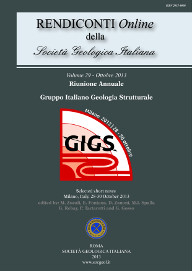
Structural analysis of Chefchaouen area in the Western Rif (Morocco)
Francesco D’Assisi Tramparulo (a), Sabatino Ciarcia (a), Bilal El Ouaragli (b), Stefano Vitale (a) & Mohamed Najib Zaghloul (b)
(a) Dipartimento di Scienze della Terra, dell'Ambiente e delle Risorse (DiSTAR), Università di Napoli Federico II, Largo San Marcellino 10, 80138, Napoli, Italy.
(b) Department of Earth Sciences, F.S.T.-Tangier, University of Abdelmalek Essaadi, Morocco.
Volume: 29/2013
Pages: 183-186
Abstract
This paper provides a structural analysis of the Chefchaouen area, in the Northern Rif. Here the Dorsale Calcaire succession tectonically superpose the Predorsalian Unit. Both successions overthrust the Massylian Unit. The carbonates of the Dorsale Calcaire are characterized by pre-orogenic structures, such as normal faults, veins and fractures, resulting from extension related to the Liassic-Dogger rifting of the Neotethys domain. The successive inclusion of these rocks in the orogenic wedge, mainly occurred in the Miocene time, has deformed the most of pre-orogenic structures in a passive fashion, without an overall reverse reactivation. The Predorsalian Unit is characterized by a two hundred meters thick shear zone located close to the contact with the Dorsale Calcaire carbonates. Here the dominantly pelitic levels are highly deformed by (i) C’ type shear bands indicating a mean WSW tectonic transport and (ii) conjugate extensional shear planes marking an extension both orthogonal and parallel to the shear direction. Such as the previous succession, conjugate extensional shear bands and normal faults indicate a horizontal extension parallel to the thrust front synchronous with the mainly WSW-directed overthrusting. Also the Massylian succession shows a progressive deformation characterized by two superposed fold sets. The whole thrust sheet pile recorded a further shortening, characterized by a NW-SE direction, expressed by several reverse and thrust faults and related folds. Finally strike-slip and normal faults were the last deformation structures recorded in the analyzed rocks.
Keywords
Get Full Text